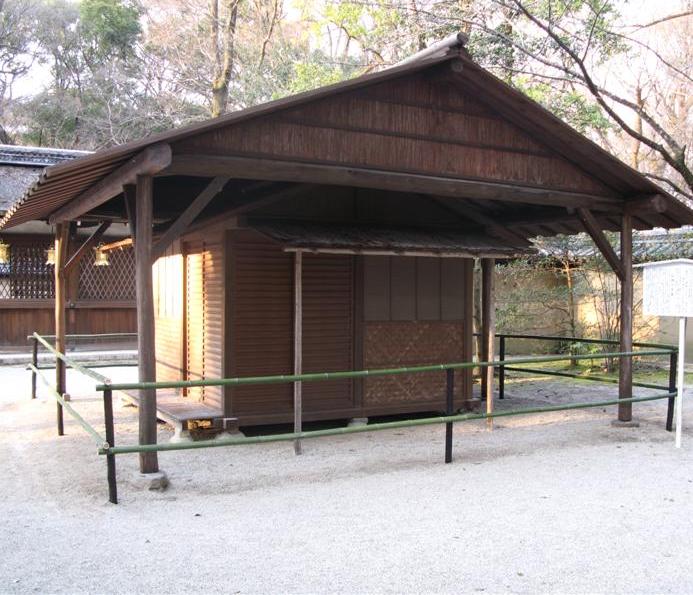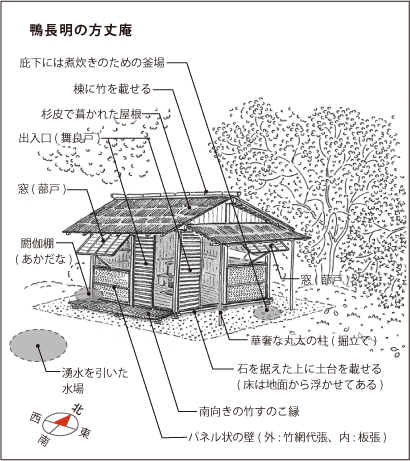In Meditation in the Wild: Buddhism's Origin in the Heart of Nature, Charles S. Fisher writes:
Not that it's easy; as a quotation from Theravada scholar Richard Gombrich points out:
But outdoor practice was hard – even harder than it is now – with dangerous wildlife and tribal warriors still ruling the outback, and the impulse to organise was strong. Yet The Kindred Sayings of Kassapa show the Buddha "bemoan[ing] the passing of the forest way of life and criticis[ing] those who depart from it"; he may have gone so far as to advocate a straight-up return to hunter-gathering, according to texts that describe his sangha living off the land, hunting game, and never returning to the Red Dust World. The fact that Buddhism spread to new lands precisely as Indian forests were clearcut leads one to wonder what exactly the motivations of those first "missionaries" were. (It also throws intriguing light on the Bodhidharma story. Canon holds that when asked why he came all the way to China to sit under a tree, he replied: "Because this is the best tree in the world." Perhaps his actual words were something like, "Because you still have trees.")
Conjecture aside, the founding generation of Buddhists exhorted aspirants to imitate Gautama literally. Mahakasyapa, a member of the Buddha's inner circle, died a loud and proud hermit, as did no less than Sariputra, of Heart Sutra fame. Finally, reports of early Western observers – Greek travellers – confirm that the first Buddhists were itinerants, without clergy or temples.
But as the movement grew respectable and sedentary, hermits were increasingly viewed as "unsocial, possibly antisocial, and potentially dangerous to established Buddhism." This last repeated pious tales of the Buddha's forest practice, but openly discouraged others from emulating it. Old-school monks, known as "mahallas", were accused of backsliding and dissolution and reviled by the ordained. (Some verses quoted in Wild are stunningly similar to the rant St. Benedict unleashed on Sarabaites and Gyrovagues at an identical stage in Christian history.)
To be sure, over the past 2500 years Buddhist back-to-the-landers have continued to crop up; modern Zen and Theravada are remnants of two such rebellions. Possibly Wild's greatest gift is the two and half millennia of these forgotten reformers it lifts from obscurity. Along the way its author weighs the relative merit of individual cases. He reviews Issa's suburban eremiticism, which echoes most current hermit practices, with guarded approval, but – interestingly – takes Bashō, Ryokan, and Kamo No Chomei firmly to the woodshed.
And that's where I get off the train. In these passages, Fisher reminds me of Thoreau's critics, calling down suspects for claims they never made. His indictment of Bashō does ring, but he repeatedly spins individual innovation in self-directed practices as weak or duplicitous; in the case of Ikkyu, he indulges in crass bourgeois morality. Somehow, in all of his research on us, he missed our core vow: "I will neither take nor give orders." I may raise an eyebrow at others (OK: I do raise an eyebrow at others) but ultimately I have no right to deplore them. Licence to judge is a delusion of the ordained.
But this mild annoyance in no way diminishes the significance of Fisher's work. His journalism is both intrepid and thorough, penetrating the Thai forest lineage – a modern restoration movement – at length and documenting the gradual deterioration of Zen, from Bodhidharma's boldly-planted hermit flag, to the dismissal of 19th century hermit Ryokan (his own beefs with him aside) as a "lunatic". He finishes with an account of his own brushes with eremitical practice (Fisher is not a practising hermit per se, but is attracted to our forms) and a light survey of four contemporary American hermits. All in all, it's the most comprehensive treatment of the subject I've found anywhere.
And I found it impossible to put down. With any luck, Meditation in the Wild will stand for many years as Eremitical Buddhism 101 for sincere students of the Buddha's way.
"Buddhism was born in the forests of India. [...] The Buddha found his original revelation while practicing as a forest monk. [...] He developed an understanding of nature which would become part of the remedy he proposed for the problem of human discontent. [...] He chose wild nature - the evolutionary context in which humans arose - as the place to do this. [...] He went to the place in the human mind where there is understanding without words."The next 315 pages go on to prove his thesis.
Not that it's easy; as a quotation from Theravada scholar Richard Gombrich points out:
"So much of the material attributed to [the Buddha]… is so obviously inauthentic that we can suspect almost everything. In fact, it seems impossible to establish what the Buddha really taught. We can only know what early Buddhists believed he taught."And this, as it happens, is very different from what we've been told. For example, some of their records maintain that Gautama encountered his famous Four Sights on the way to the forest, where he sat and pondered what he saw. Others suggest that the pivotal debate between Mara and Gautama on the eve of his Enlightenment was actually about the Devil's contention that the young man had no right to strive to end suffering. All those statues of him touching the earth, they contend, depict him saying, "Check it out, dipstick: I'm home. Go find someone who cares."
But outdoor practice was hard – even harder than it is now – with dangerous wildlife and tribal warriors still ruling the outback, and the impulse to organise was strong. Yet The Kindred Sayings of Kassapa show the Buddha "bemoan[ing] the passing of the forest way of life and criticis[ing] those who depart from it"; he may have gone so far as to advocate a straight-up return to hunter-gathering, according to texts that describe his sangha living off the land, hunting game, and never returning to the Red Dust World. The fact that Buddhism spread to new lands precisely as Indian forests were clearcut leads one to wonder what exactly the motivations of those first "missionaries" were. (It also throws intriguing light on the Bodhidharma story. Canon holds that when asked why he came all the way to China to sit under a tree, he replied: "Because this is the best tree in the world." Perhaps his actual words were something like, "Because you still have trees.")
Conjecture aside, the founding generation of Buddhists exhorted aspirants to imitate Gautama literally. Mahakasyapa, a member of the Buddha's inner circle, died a loud and proud hermit, as did no less than Sariputra, of Heart Sutra fame. Finally, reports of early Western observers – Greek travellers – confirm that the first Buddhists were itinerants, without clergy or temples.
But as the movement grew respectable and sedentary, hermits were increasingly viewed as "unsocial, possibly antisocial, and potentially dangerous to established Buddhism." This last repeated pious tales of the Buddha's forest practice, but openly discouraged others from emulating it. Old-school monks, known as "mahallas", were accused of backsliding and dissolution and reviled by the ordained. (Some verses quoted in Wild are stunningly similar to the rant St. Benedict unleashed on Sarabaites and Gyrovagues at an identical stage in Christian history.)
To be sure, over the past 2500 years Buddhist back-to-the-landers have continued to crop up; modern Zen and Theravada are remnants of two such rebellions. Possibly Wild's greatest gift is the two and half millennia of these forgotten reformers it lifts from obscurity. Along the way its author weighs the relative merit of individual cases. He reviews Issa's suburban eremiticism, which echoes most current hermit practices, with guarded approval, but – interestingly – takes Bashō, Ryokan, and Kamo No Chomei firmly to the woodshed.
And that's where I get off the train. In these passages, Fisher reminds me of Thoreau's critics, calling down suspects for claims they never made. His indictment of Bashō does ring, but he repeatedly spins individual innovation in self-directed practices as weak or duplicitous; in the case of Ikkyu, he indulges in crass bourgeois morality. Somehow, in all of his research on us, he missed our core vow: "I will neither take nor give orders." I may raise an eyebrow at others (OK: I do raise an eyebrow at others) but ultimately I have no right to deplore them. Licence to judge is a delusion of the ordained.
But this mild annoyance in no way diminishes the significance of Fisher's work. His journalism is both intrepid and thorough, penetrating the Thai forest lineage – a modern restoration movement – at length and documenting the gradual deterioration of Zen, from Bodhidharma's boldly-planted hermit flag, to the dismissal of 19th century hermit Ryokan (his own beefs with him aside) as a "lunatic". He finishes with an account of his own brushes with eremitical practice (Fisher is not a practising hermit per se, but is attracted to our forms) and a light survey of four contemporary American hermits. All in all, it's the most comprehensive treatment of the subject I've found anywhere.
And I found it impossible to put down. With any luck, Meditation in the Wild will stand for many years as Eremitical Buddhism 101 for sincere students of the Buddha's way.







